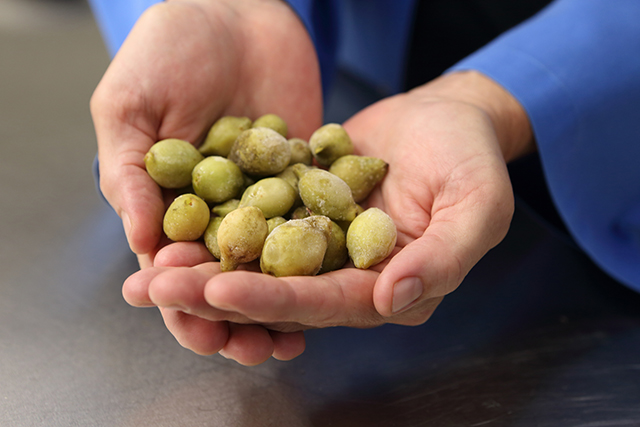We have a problem with the food we eat.
We waste too much of it — in Australia alone, food waste costs the economy $36.6 billion a year — and our diets aren’t diverse enough to always provide us with the micronutrients our bodies need.

This leads to the issue of hidden hunger — where people are eating enough food for energy but not enough variety of foods to ensure their health needs are met — which is thought to affect more than two billion people worldwide.
It’s a problem not just affecting countries in the Global South. In Australia, over a third of households in the last year experienced moderate to severe food insecurity.
Getting more native Australian foods onto our plates could be one way of addressing this issue.
Globally, 6,000 plant species have been grown for food.
Of those, fewer than 200 have made major contributions to food security at a global, regional or national level, and only nine of those species account for 66 percent of total crop production today.
There’s an opportunity for Australia here, thanks to the blessing of our biodiversity.
We have an estimated 24,716 plant species in Australia, 86 percent of which are found nowhere else in the world.
Many have been used as sources of food and medicine by Indigenous communities for over 60,000 years and are still eaten today, especially in remote parts of Australia.
Indigenous Australians have the traditional knowledge and connection to Country to grow these plants, know what is safe and good for us to eat, and how best to prepare it.
Researchers are working with communities to help them turn native foods into nutritious, sustainable and value-added products now in much demand by mainstream consumers.
One of the native foods that has been extensively studied is wattle seed.
Wattle seed is a legume that is grown right across Australia and belongs to the acacia family.
In comparison to more familiar foods like wheat and chickpea, wattle seed flour has a protein content comparable to dry chickpeas but much higher than wholemeal flour, its fat content is higher than both.
What’s really interesting is that it is low in carbohydrates and high in dietary fibre.
This makes wattle seed a very attractive ingredient to incorporate into other foods or develop into a healthy food product in its own right, particularly for people at risk of developing type 2 diabetes.
And that’s what researchers did in partnership with a catering company in the Northern Territory.
They developed a wholemeal bread roll that also contained a certain amount of wattleseed flour.
This increased the protein and dietary fibre content of the roll, as well as the levels of magnesium, potassium and iron it contained.
But more importantly, they also tested the product with some of the harshest food critics you can find — kids!
When the rolls were taken to schools in Brisbane, kids were quick to wrap them up and take them home.
What this tells us is that by adding a certain amount of a nutrient-dense food, you can easily change the nutrient composition of everyday food products that people eat.
Now that researchers have generated this scientific information for wattle seed in partnership with Indigenous communities and it’s been published, other people are starting to be adventurous and incorporate it into their own cooking.
For example, Glaiza Victor-Calderon is a Filipino chef living in Western Australia and she uses wattle seed in her recipe for biko, a famous Filipino sticky rice cake.
PhD student Sera Susan Jacob in collaboration with industry partners, created recipes using more than 20 percent wattleseed, including for a curry-style savoury porridge, muesli bars and a gluten-free veggie burger patty.
Researchers have also been studying the Kakadu plum for almost 15 years.
Kakadu plums grow across northern Australia in some of the most remote parts of the country.
While they haven’t been cultivated, in the wild you can get thousands and thousands of trees from which can be harvested tons of fruit.
Indigenous Australians have been eating this fruit for many years. According to traditional knowledge, eating the fruit can also cure a headache.
Now researchers are combining this traditional knowledge with scientific studies of the fruit to understand more about its nutritional value.
What’s really interesting about the Kakadu plum is that it’s the fruit with the highest known vitamin C content in the world. It also contains high levels of ellagic acid, known for its antioxidant properties.
In a study published earlier this year, researchers used a gut model to partially mimic how the fruit might be metabolised while going through the human digestive system.
They found that the colon microbiome transformed the compounds found in Kakadu plums, offering multiple health benefits.
For example, gallic acid, a type of phenolic acid found in the fruit, was converted into pyrogallol, a metabolite with high anti-inflammatory properties and antioxidant activity.
Now the hope is that this combined traditional and scientific knowledge of native Australian foods, as well as the many health benefits they offer, will lead to community-run enterprises getting access to market. This would allow Indigenous communities to get economic benefits from these foods, retain their cultural knowledge and enjoy positive social impacts as well.
This hope is already being realised with the Kakadu plum, with the first Indigenous-led, owned and controlled value chain for any native food product.
The wild harvesting of the fruit is done by communities, all the processing is done within communities, leading ultimately to their own branded products.
Now researchers and Indigenous enterprises are working together using blockchain technology to develop the ausTukka app to be able to trace the provenance of native Australian foods and botanicals.
Maybe returning to traditional native foods with a rich human history of more than 60,000 years is a way of fixing the problem of our poorer modern diets.
This article was originally published under Creative Commons by 360info.
Contact: Professor Yasmina Sultanbawa, Director for the Centre for Nutrition and Food Sciences, The University of Queensland, QAAFI y.sultanbawa@uq.edu.au
The Queensland Alliance for Agriculture and Food Innovation is a research institute at The University of Queensland supported by the Queensland Government via the Queensland Department of Agriculture and Fisheries.

